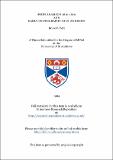Files in this item
John Adamson 1810-1870 and early photography at St Andrews
Item metadata
| dc.contributor.advisor | Kemp, Martin | |
| dc.contributor.author | Pert, Bruce F. | |
| dc.coverage.spatial | 234, 37 p. | en_US |
| dc.date.accessioned | 2019-11-12T14:25:05Z | |
| dc.date.available | 2019-11-12T14:25:05Z | |
| dc.date.issued | 1994-09-30 | |
| dc.identifier.uri | https://hdl.handle.net/10023/18901 | |
| dc.description.abstract | John Adamson (1809-1870) was the eldest of 10 children born to Rachel and Alexander Adamson, tenant of Burnside Farm near Boarhills, a few miles east of St. Andrews. If photography had never been invented Adamson would still have been a figure of more than passing interest. His medical studies in Edinburgh took place against a background of Knox the Anatomist and the Burke and Hare scandal. His student contemporaries included James Y. Simpson and Charles Darwin; he studied in Paris around the time of the July revolution; he was a ship's surgeon on a voyage to China; he helped establish the Literary and Philosophical Society's Museum and remained its curator from its beginning in 1838 until his death in 1870. His obituaries are testimony to his dedication to medicine and his papers on sanitation are a similar tribute to his commitment towards public health. Within weeks of Talbot's discovery of Photogenic Drawing, photography was on the Agenda of the Literary and Philosophical Society in St. Andrews. Talbot's friendship with Sir David Brewster gave St. Andrews a major part to play in the early history of photography with John Adamson taking a leading role. Whether medicine or photography was Adamson's major interest is a moot point but one feels very much that Adamson was a doctor first and foremost and for this reason it seemed appropriate to discuss at some length his medical career. He was also a man of passionate interests however, 2 including chemistry and natural history and it would have been surprising had he not found photography an irresistible challenge. In looking at Adamson's photographic career the main source has been the Minute Book of the Literary and Philosophical Society which, where appropriate, has been linked to photographic developments elsewhere. Photographic references from this volume are produced in Appendix 1. Overall, it is hoped that this dissertation may serve to place John Adamson in a clearer context with regard to both his medical and photographic career. | en_US |
| dc.language.iso | en | en_US |
| dc.publisher | University of St Andrews | |
| dc.title | John Adamson 1810-1870 and early photography at St Andrews | en_US |
| dc.type | Thesis | en_US |
| dc.type.qualificationlevel | Doctoral | en_US |
| dc.type.qualificationname | MPhil Master of Philosophy | en_US |
| dc.publisher.institution | The University of St Andrews | en_US |
This item appears in the following Collection(s)
Items in the St Andrews Research Repository are protected by copyright, with all rights reserved, unless otherwise indicated.

